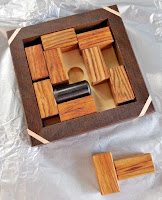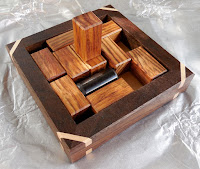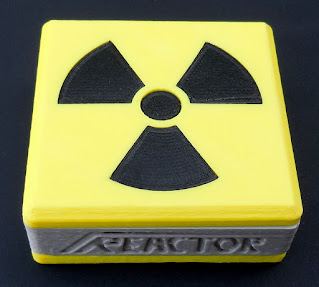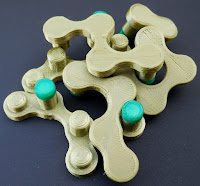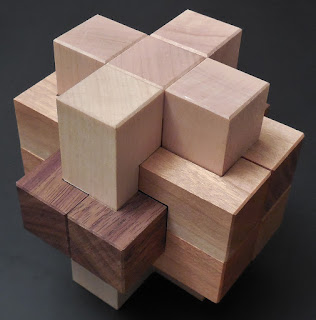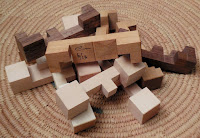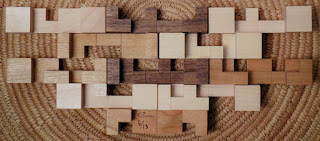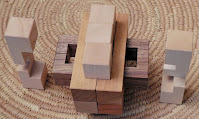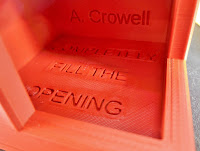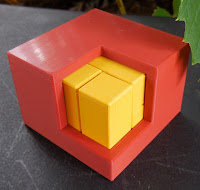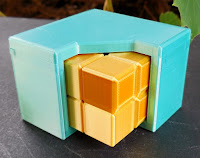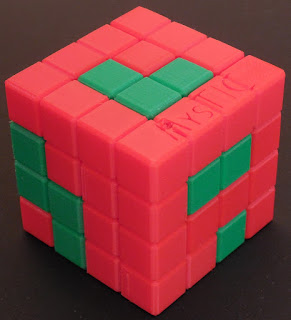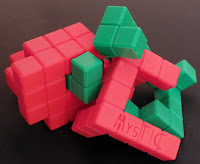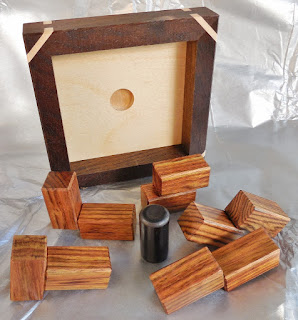 Finding a specific puzzle in a heap of puzzles is a puzzle in itself. I’m sure that most puzzlers that have crossed the 1000+ threshold have a sophisticated puzzle database that can be used to identify, describe, and locate any puzzle within a heartbeat. My sophisticated system, refined over several decades of puzzle collecting, is a 2-bin approach. New puzzles go in one clear plastic tub and solved puzzles go in another. Once a tub is filled, another is started. Unfortunately, there are probably more new tubs than finished tubs at this point in time. Since the tubs are mostly chronological, finding a puzzle involves locating the tub from the era that the puzzle was acquired or solved. I had the opportunity to test this system when I saw that Cubicdissection may rerelease Artefacts and I decided to take it out for this post.
Finding a specific puzzle in a heap of puzzles is a puzzle in itself. I’m sure that most puzzlers that have crossed the 1000+ threshold have a sophisticated puzzle database that can be used to identify, describe, and locate any puzzle within a heartbeat. My sophisticated system, refined over several decades of puzzle collecting, is a 2-bin approach. New puzzles go in one clear plastic tub and solved puzzles go in another. Once a tub is filled, another is started. Unfortunately, there are probably more new tubs than finished tubs at this point in time. Since the tubs are mostly chronological, finding a puzzle involves locating the tub from the era that the puzzle was acquired or solved. I had the opportunity to test this system when I saw that Cubicdissection may rerelease Artefacts and I decided to take it out for this post.
In 2015, Packmaster Frederic Boucher entered a 2D packing puzzle in the Nob Yoshigahara Puzzle Design Competition. This packing conundrum consisted of 5 wooden pieces and a metal rod that had to be packed into a square frame. Each of the wooden pieces is made from two 1x 1x2 blocks. Of course, the difficulty with these pieces is that they were glued up all wrong and are shifted by half a unit.
The following year, Cubicdissection released a run of Artefacts in October 2016. The Walnut frame was completed with a Baltic Birch bottom and Maple spines. Along with the pieces made from Chechen, the puzzle is very handsome. The steel dowel is much heavier than the other pieces and the black color makes it blend in nicely with the rest of the puzzle.
Artefacts has 2 challenges: 1) Pack the frame with all the pieces with the rod laying on its side, and 2) Pack the frame with all the pieces with the rod standing up vertically from a hole in the center of the frame. Two challenges for the price of one!
The Cubicdissection site indicates that there are 3 ways to pack the pieces in the frame with the rod laying down. 3 Ways! Seems like you would have to work real hard not to stumble upon one of those solutions. However, you may find yourself spending quite a bit of time trying to put the 5 Chechen pieces in the fame only to discover that the rod doesn’t fit.
Once you get a feel for how the pieces work together, it shouldn’t take too long to find one of the solutions. After the first one is found, you then have to decide whether to look for the others. Personally, I’m a one and done type of solver and once the first one is found I consider it solved. If it has hundreds of other solutions, I generally don’t feel obligated to hunt every one down. However, in this case there were only 3 and I’d be embarrassed to admit to not finding them all.
Finding all 3 solutions took about 3 times longer than finding 1. The second was a little faster and the third was a little slower. Of course, you need to make sure that you are not finding the same solution over and over again. To help you with that, I did notice that the steel rod was in a different place for all 3, so you can use that as a way to identify the different solutions. Another interesting fact is that only one of the wooden pieces occupies the same position for all 3 solutions. So no, you can’t just swap a couple of pieces and expect to find another solution.
For the second challenge, you place the steel rod standing up in the hole in the center of the frame and then add the remaining 5 pieces. Standing that steel dowel on end means that it occupies less than half the space it did laying down. So, it should be easier, right? Not so much. This one is not as straight forward as the other challenge and has only 1 solution. This challenge took about the same time as finding a solution for the first challenge.
The tolerances on this version of Artefacts from Cubicdissection are very exact. The 3 solutions for the dowel laying down are fairly loose in the frame but the solution for the dowel standing on end is snug letting you know which solution drove the frame size. The steel rod also fits snugly in the round hole and won’t fall out if the puzzle is tipped.
If your interested in acquiring a copy of the puzzle for your own, keep an eye on the Cubicdissection Upcoming page.
